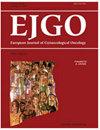Identification of a 3-cuproptosis-associated-lncRNA-signature that predicts the prognosis of endometrial cancer patients
IF 0.5
4区 医学
Q4 OBSTETRICS & GYNECOLOGY
引用次数: 0
Abstract
Endometrial carcinoma is a common malignancy among peri-menopausal and menopausal females, even among some women of reproductive age. The treatment approach to endometrial cancer is a platinum-based regimen combined with paclitaxel, which may be unsatisfactory. A copper-mediated binding of lipoylated constituents of tricarboxylic acid cycle has been found recently, which brings about lethal protein stress and cell death, a phenomenon termed cuproptosis. As an innovative method of cell death, cuproptosis could be designed for cancer treatment and many aspects remain unaddressed. In our study, clinical, genomic, and mutational profiles of uterine corpus endometrial carcinoma (UCEC) patients were obtained from The Cancer Genome Atlas and cuproptosis-related genes and long non-coding RNAs (lncRNAs) were acquired thereafter. Co-expression and Cox regression analyses led to the development of a prognostic signature. Patients were separated into two groups (high- and low-risk groups) and survival analysis, risk score calculation, multivariate Cox analysis, and subgroup validation were implemented to determine the utility of the signature. Differentially expressed genes (DEGs) between the two groups were subjected to Gene Ontology and Kyoto Encyclopedia of Genes and Genomes enrichment analyses. Immune-related functional analysis and tumor mutation burden (TMB) analysis were performed. Three independent high-risk cuproptosis-related lncRNAs were finally confirmed and incorporated into the prognostic model, including BX322234.1, LINC01545 and LINC01224. Areas under the curve for 1-, 3- and 5-year survival were 0.717, 0.688 and 0.714, respectively. The risk model served as an independent factor to predict prognosis. Patients with high-risk and low TMB tended to have poor prognoses. Enrichment analysis demonstrated that DEGs were mostly associated with immune responses. In conclusion, the three high-risk cuproptosis-related lncRNAs could predict the prognosis of UCEC patients with higher power, where patients with high-risk and low TMB are prone to have the worst prognosis, which broadens the pattern of clinical treatment and applications.鉴定预测子宫内膜癌患者预后的3- cuproplasia -associated- lncrna标记
子宫内膜癌是一种常见的恶性肿瘤在围绝经期和绝经期女性,甚至在一些育龄妇女。子宫内膜癌的治疗方法是铂基方案联合紫杉醇,这可能不令人满意。最近发现了一种铜介导的三羧酸循环脂酰化成分的结合,这种结合会导致致命的蛋白质应激和细胞死亡,这种现象被称为铜还原。作为一种创新的细胞死亡方法,铜增生可以设计用于癌症治疗,但许多方面仍有待解决。在我们的研究中,我们从癌症基因组图谱中获得了子宫肌体子宫内膜癌(UCEC)患者的临床、基因组和突变谱,并获得了cuprosiosis相关基因和长链非编码rna (lncRNAs)。共表达和Cox回归分析导致预后特征的发展。将患者分为两组(高风险组和低风险组),并进行生存分析、风险评分计算、多变量Cox分析和亚组验证,以确定签名的效用。对两组差异表达基因(DEGs)进行基因本体和京都基因与基因组百科全书富集分析。进行免疫相关功能分析和肿瘤突变负荷(TMB)分析。最终确认了3个独立的高风险铜增生相关lncrna,并将其纳入预后模型,分别为BX322234.1、LINC01545和LINC01224。1年、3年和5年生存曲线下面积分别为0.717、0.688和0.714。风险模型是预测预后的独立因素。高风险和低TMB患者往往预后较差。富集分析表明,deg主要与免疫应答相关。综上所述,这3种高风险铜肾病相关lncrna能够以较高的功率预测UCEC患者的预后,其中高风险、低TMB的患者往往预后最差,拓宽了临床治疗和应用的模式。
本文章由计算机程序翻译,如有差异,请以英文原文为准。
求助全文
约1分钟内获得全文
求助全文
来源期刊
自引率
25.00%
发文量
58
审稿时长
1 months
期刊介绍:
EJGO is dedicated to publishing editorial articles in the Distinguished Expert Series and original research papers, case reports, letters to the Editor, book reviews, and newsletters. The Journal was founded in 1980 the second gynaecologic oncology hyperspecialization Journal in the world. Its aim is the diffusion of scientific, clinical and practical progress, and knowledge in female neoplastic diseases in an interdisciplinary approach among gynaecologists, oncologists, radiotherapists, surgeons, chemotherapists, pathologists, epidemiologists, and so on.

 求助内容:
求助内容: 应助结果提醒方式:
应助结果提醒方式:


